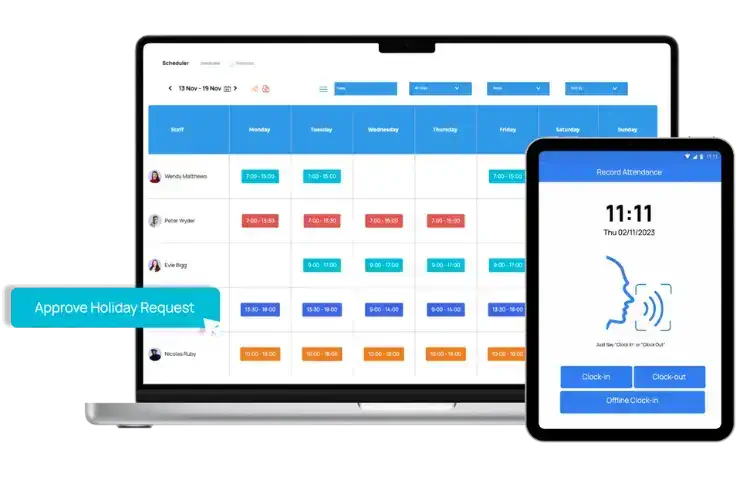Selecting the perfect attendance management software for your organisation can be a daunting task, particularly given the myriad options available in today’s market. An effective attendance management solution not only streamlines the tracking of employee attendance but also enhances overall productivity and efficiency within the workplace.
With a well-designed system in place, organisations can reduce the administrative burden associated with manual attendance processes, allowing for more time to focus on core business functions. However, the variety of features and functionalities offered by different vendors can make it challenging to determine which solution aligns best with your specific needs.
Today, we aim to guide you through the essential factors to consider when choosing an attendance management system.
Understand Your Organisation’s Needs
Before diving into the plethora of available options, it’s essential to conduct a thorough assessment of your organisation’s specific requirements. Begin by identifying the unique challenges your organisation faces in terms of attendance tracking. Consider the size of your workforce, the variety of roles, and the nature of work schedules, including any remote or flexible working arrangements.
Different departments may have distinct attendance tracking needs, so involving key stakeholders from various teams can provide valuable insights. Additionally, think about any compliance and regulatory requirements that your organisation must adhere to, as these can significantly influence the type of attendance management system you choose.
Evaluate whether you need features such as biometric verification, mobile app integration, or real-time reporting. Understanding the pain points and the specific functionalities you require will help you narrow down the options and select a solution that aligns well with your operational goals. Taking the time to map out these needs ensures that the chosen system will be a good fit for your organisation’s daily operations and future growth.
Evaluate Key Features
When evaluating key features of an attendance management software, it’s crucial to prioritise functionalities that address your organisation’s specific requirements. Look for a system that offers comprehensive time-tracking capabilities, including clock-in/out options and automated timesheet generation. Ensure the software provides accurate and secure attendance recording methods, such as biometric verification or geolocation tracking, to prevent time fraud.
Additionally, real-time reporting and analytics tools are invaluable for monitoring attendance patterns and identifying trends that may affect productivity.
Consider features that facilitate ease of use, such as intuitive dashboards and user-friendly interfaces, which can simplify the learning curve for employees and administrators alike. Integration with existing HR and payroll systems is also vital for seamless data transfer and reducing administrative workload. Mobile accessibility can be particularly beneficial for organisations with remote or mobile workforces, allowing employees to log their attendance from anywhere.
Another key feature to consider is the system’s ability to handle different types of leave and absence management, ensuring compliance with company policies and legal regulations. Automated notifications and reminders can help in managing approvals and keeping everyone informed. By carefully evaluating these features, you can ensure the chosen system aligns well with your operational needs and enhances overall efficiency.
Consider User-Friendliness
When choosing an attendance management system, user-friendliness is a critical factor that can significantly impact its adoption and effectiveness. An intuitive interface with a clean, organised layout can make it easier for employees and administrators to navigate and use the system efficiently. Look for features such as simple clock-in/out processes and straightforward leave application workflows that minimise the learning curve.
Training and support resources, such as comprehensive user guides, video tutorials, and responsive customer support, can further enhance user experience and ensure smooth implementation. It’s also beneficial to opt for software that offers customisable dashboards and reports, allowing users to tailor the system to their specific needs and preferences.
Another aspect to consider is the system’s accessibility across various devices. Ensuring that the software is mobile-friendly and accessible via smartphones and tablets can be particularly advantageous for organisations with a mobile workforce or remote employees. A user-friendly system not only improves efficiency but also increases employee satisfaction and engagement, leading to better overall compliance with attendance policies. Prioritising user experience in your selection process will help ensure that the chosen attendance management system is well-received and effectively utilised within your organisation.
Assess Compatibility and Integration
When selecting an attendance management system, it’s vital to ensure that the software is compatible with your existing IT infrastructure and can seamlessly integrate with other systems in use, such as HR and payroll software. This interoperability is crucial for reducing data silos and ensuring smooth data flow across various platforms, which in turn enhances overall efficiency.
Investigate whether the system supports common file formats and data exchange protocols to facilitate easy data migration and synchronisation. Additionally, consider the flexibility of the software in terms of API availability, which can allow for custom integrations tailored to your organisation’s specific needs. It’s also important to evaluate the vendor’s track record in providing regular software updates and support to address any compatibility issues that may arise due to changes in your IT environment.
Ensuring that the attendance management system can work harmoniously with your existing tools will not only streamline processes but also minimise the potential for operational disruptions, helping your organisation maintain a cohesive and efficient workflow.
Check for Scalability
As your organisation grows, so will its attendance management needs. It’s crucial to choose a system that can scale seamlessly with your expansion plans. Look for a solution that supports an increasing number of users and can handle more complex attendance tracking requirements as your workforce diversifies.
Scalability also means the software should be capable of managing larger volumes of data without compromising performance. Consider whether the system can adapt to new organisational structures, such as additional departments or locations, and whether it can accommodate various types of work arrangements, including remote and flexible working.
Additionally, assess the vendor’s ability to provide regular updates and enhancements to the software, ensuring it remains relevant and capable of meeting evolving demands. Opting for a scalable attendance management system will help future-proof your investment, allowing it to grow in tandem with your organisation’s changing needs.
Evaluate Cost and Return on Investment
When evaluating the cost of an attendance management system, it’s essential to consider both the upfront expenses and any ongoing costs, such as subscription fees, maintenance, and support. While it may be tempting to opt for a lower-priced solution, it’s crucial to weigh the cost against the potential benefits and efficiencies the system can bring to your organisation.
Look at the value proposition of the software in terms of time saved, error reduction, and enhanced productivity. Conduct a cost-benefit analysis to determine the return on investment (ROI). Consider factors such as reduced administrative workload, improved accuracy in payroll processing, and the ability to make data-driven decisions based on real-time attendance analytics. Additionally, account for any savings related to compliance with labour laws and the minimisation of time fraud. A more expensive system may offer features that lead to greater long-term savings and efficiencies. By thoroughly assessing the cost against the potential ROI, you can make a more informed decision that aligns with your organisation’s financial goals and operational needs.
Read also: Why Every UK Resident Wants a Syna World




